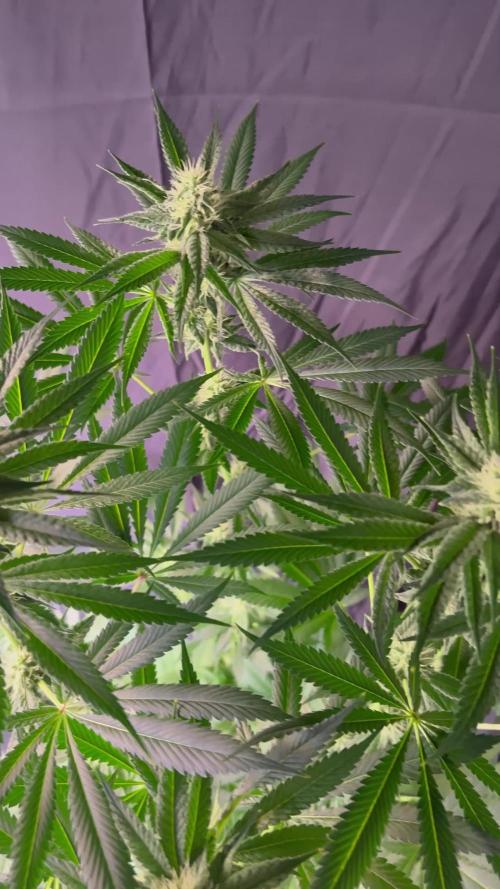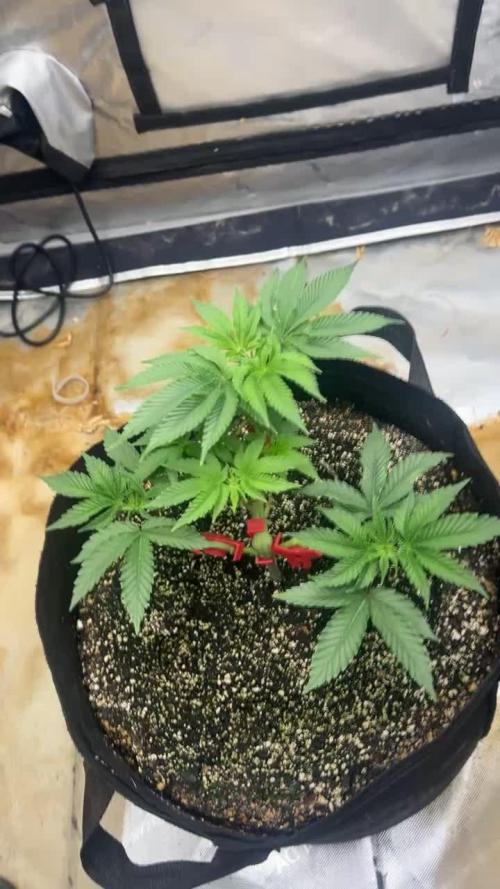The Grow Awards 2026 🏆 



























Likes
Comments
Share


@BigUncGotGaz
Follow
(Day 36veg) - (Jan7)
On this week I prepared my feed mix with 8L of distilled water & officially started my AutoPot system
I lost one side of my top on pheno #1
So I decided to top my “to be cloned” branches & just go with toppings only
for this Grow.
Pheno #2 Performed a topping on each top layer.
Expecting 8 new tops
Pheno #3 sent away to another growbud
Likes
2
Share


@High_Grade_Dadli
Follow
Missed last week update but did some cutting girls have to live up to the mission 73 between the 5 plant....added one more which was a cutting from a seed plant harvested previous...didn't look like I did anything so cut dem a few day later 85 between the same plants... only cut the lower half of G4 n smaller inside branches( going to stop they dont hold up well)
Likes
18
Share


@Jays_Not_Here_Man
Follow
More to come once I think this over, and finish up the dry and cure 🌱💨
Likes
5
Share


@Krissci
Follow
This week I have separated the plants into 2 tent, to allow for wider canopy per plant.
Day 5 - LST and defoliation needed
Likes
21
Share


@KushKeeper420
Follow
On flower day 60, it was finally time. Three days before the final cut, I did a last light watering with plain water. The last 36 hours, the lights stayed on. In the end, I had around 20–30% amber trichomes. I'm super happy with the result. Trim jail was exhausting but totally worth it. The harvest is now right in the middle of curing.
As for the smell: a sharp, earthy, leathery diesel mix with hints of lemon. The fuel note is, to my delight, much stronger than expected.
Incredibly sticky buds. Sparkling flowers.
Thanks so much for following along with the grow journal! Maybe it'll help someone with planning or give a general preview for a future grow of this strain. Much love and happy growing!
Likes
6
Share


@AutoCrazy
Follow
Week 2 of flower
The Red Hot Cookies and Lemon Orange are really stretching out. Glad I put them at the back of the tent. The Mimosa X Orange Punch is taking her time as far as flowering goes. The Black Apple Hitchcock (there is a separate diary for this plant) has been even slower transitioning into flower. But all in all the plants are happy so I am happy.
6.0 pH
500 ppm
65F water temp
71 tent temp
41 % RH
Likes
249
Share


@Metatronix
Follow
A big hello to all the cannabis growing gardeners...and all the other visitors that came across my grow journal.
This week i need to change the reservoir again, the plants drink solution just as I add fresh water the EC stays at 2.7 and i need to add PK and Calmag so that's why.
The weather outside is very cold this whole week around -18 degree Celsius at night...this made my reservoir water go under 15 degree Celsius.
Since i ran the Spider Farmer UV lights i noticed some purples on my cannabis plants i think it's their doing....i run it now for two weeks the UVs
----------------------------------------------------------------------------------
The SE 7000 is hanged at 40 cm. over the canopy and runs at 520W.
This whole grow's main sponsor is Spider Farmer. You can easily obtain all the great grow equipment we use at: spider-farmer.com
A big thank you to Jessie and the whole Spider Farmer crew for supporting me with the newest technological advancements in horticulture. Thanks to them what i do here is possible.
Thank you Zamnesia for giving me the opportunity to try out your stock.
zamnesia.com/uk/7686-zamnesia-seeds-do-si-dos.html
20% discount code: ZAMMIGD2023
Plagron did send us their Contest package for the Power Buds competition .
Thank you for your visit, please leave a like and hope to see you beck here in about a week.
Likes
3
Share


@Ninjabuds
Follow
Gary Payton is one of my favs of this run. The plant stacked very well also the plant grew straight up and is slim. The plant would be great for sea of green with a bunch of the same plant you could fit a few extra plants in per 4x4 because of its sturuture. Also it smell like skunk really strong
Likes
3
Share


@Jointjourney
Follow
The little ones are developing well, unfortunately there are a few minor nutrient problems in the direction of Calmag with the Morello Cherries and also slight signs of this with the TerpyZ Punch. I counteracted this with a foliar spray. The pH value of the hydrosystem has unfortunately dropped a little to 5.5, which I have equalised with ph up from Plagron. The plants are currently getting light between 800-900 ppfd and as soon as the stretch starts, l'll increase this to 1000 ppfd. Both ladies are slowly starting to smell.
Likes
9
Share


@Fatnastyz
Follow
2-25
Did a full water with run off.
Gave 1/4 nutes made 2 gallons of water.
PH 6.2. Ppm 580
Silica 1.5 ml
Micro 4 ml went a little under just to be safe.
Trees none
Flowers 6 ml
Frosty Nugs 5 ml
Blast off .075 ml
Bud Strength 5 ml
Run off PH was 5.8
Run off ppm was over 4400
Feel a big fresh water coming 😂😂😂
Sheesh
3-1
1/4 nutes, no trees.
Run off ppm 950 ph 6.4
So far so good.
Likes
18
Share


@Kirsten
Follow
17.3.25:
So I watered with 2ltrs of dechlorinated water PH'd to 6.4 with 4ml Xpert Nutrients Cal-Mag amino acids.
I have really overdone the nutrients, I got carried away 😅
To try and rectify the situation, I've cut everything out except Cal-Mag amino acids.
I will try to just stick to this with some Biosys, but I'm running out of that now, too.
Anyway, with Or Without, I'm sure it'll balance out. Fingers crossed 🤞
Processing
Likes
80
Share


@Qlimax
Follow
Hello everyone!!
👉Day55 -buds fatting up nice :) nothing to do but wait :)on 2 flowers leafs turning yellow and and still some calcium deficiency
👉 Day 60 plants are great (THEY SMELL FANSTASTIC) like 1more week and i think they redy for harvest i reorgenize them again(have to stop doing that)... will also wather them last time today cca 2L/plant and i i think i will leave them in darkness for 2last days!🙂 ...i think...didnt decide yet..still reasearching x)
💚Guys have fun and heppy new year 2021!!!!!! I wish you alot new big buds in your lifes and alot more!! 👍stay positive and safe!!💚
Likes
17
Share


@Colibri_grow
Follow
Caminhando para os dias desta jornada, agora levanso somente com água.. Tive algumas dificuldades com a HR no grow devido a alta umidade em minha região que chega a 100%.. Vários dias a HR ficou entre 80 a 90% e infelizmrnte o aparelho desumidificador foi insuficiente para manter o nível ideal para o cultivo, devido a esse fator tive problemas com mofo nos em alguns poucos buds, por sorte não se espalhou para todos os buds e todas as plantas, foram apenas algumas flores que apresentaram os sintomas e logo cortei por prevenção...
Likes
13
Share


@XanHalen
Follow
Mar 24:
Watering till runoff now...
runoff ppm was 2500+...
Will be using very mild nutes to flush over 1 - 3 feeds... or until I am near my input.
Mar 26:
Continuing to use 650ppm feed with bloom focus, 2L per plant gives 15% runoff...
Runoff ppm is still very high...
I wanted to check pH of runoff but the color is so vibrant i cant use the pH drops to view color, need to get a pH probe.
Plants are thriving, no issues at all. the extra fan fixed the post-water droop.
One plant is bushy and has the most bud sites,
One is the smallest but has the most uniform structure, this one has the biggest buds and thickest stalk,
One is about in the middle of the 2.
Mar 29:
one of these girls gets droopy early when its time for water, thought the canopy was too high so i tied down some more, no cigar...
gonna try increasing calmag, if that doesent work im going to reposition in the grow box to a side instead of middle, may not need the upper end ppfd...




























